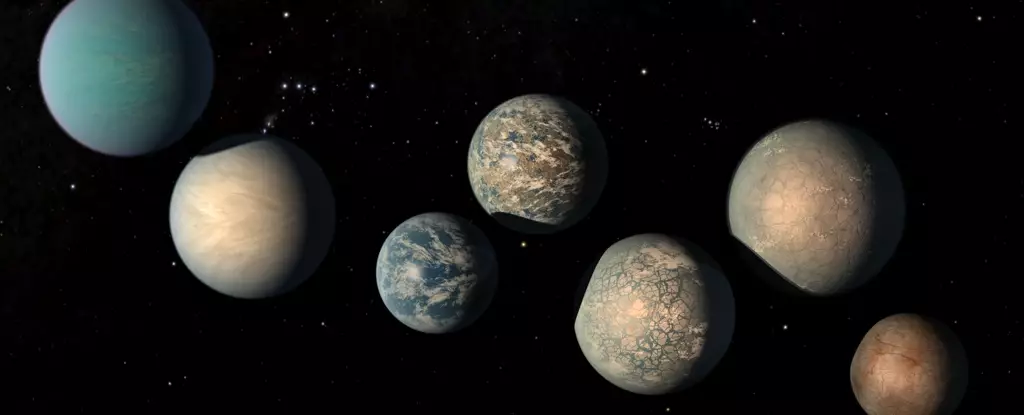In a stunning discovery that captured the imagination of astronomers and the public alike, the TRAPPIST-1 system emerged as a focal point for the search for extraterrestrial life in February 2017. Located approximately 40 light-years from Earth, this extraordinary system is home to seven Earth-sized planets orbiting a red dwarf star. Scientists have been eager to understand the potential for life on these planets, largely due to the tantalizing possibility of water—an essential building block for life as we know it. Recent research examines the intricate dynamics of water availability in this system and delves into the ongoing debate regarding the habitability of these distant worlds.
The Conflict of Habitable Conditions
Since their discovery, the habitability of the TRAPPIST-1 planets has sparked intense discussions in the scientific community. Much of the debate centers around the nature of their host star, the M-type red dwarf. Compared to our Sun, these stars are smaller, cooler, and notoriously volatile, characterized by frequent flare activity that can expose orbiting planets to harmful levels of radiation. While the TRAPPIST-1 system’s planets have potential access to water, they also face significant challenges that question their ability to retain it. Previous studies suggested that while water may be abundant, the harsh environmental conditions could lead to high rates of atmospheric water loss.
Astrobiologists are doing crucial work to assess whether the presence of water on these planets will significantly contribute to their potential for supporting life. This assessment requires not only understanding the circumstances surrounding their formation and current state but also integrating data from advanced observational tools like the James Webb Space Telescope (JWST).
Unveiling New Findings
In a recent study by a team led by astrobiologist Trent Thomas from the University of Washington, cutting-edge observations of TRAPPIST-1 c, one of the seven planets, provided new insights. Eliminating the possibility of a thick carbon dioxide atmosphere shifted previous assumptions about this world being akin to Venus. More importantly, the findings did not deny the possibility of water vapor or oxygen emerging from chemical processes, suggesting that the planet might still harbor conditions favorable for retaining water, albeit with caveats.
To better understand the implications of these findings, the team developed a comprehensive outgassing model based on Earth’s rocky planets—Mercury, Venus, Earth, and Mars. By applying geochemical filters specific to TRAPPIST-1 and integrating these findings with observational data, they examined potential outgassing rates across the various planets.
Calculating Water Dynamics in TRAPPIST-1
The team’s analysis revealed that the outgassing rates for water on the TRAPPIST-1 planets vary greatly, estimating a range between 0.03 and as much as eight times Earth’s outgassing rates. However, a significant discovery was the observation that the planets might not be experiencing substantial volcanic activity. With rates of magma movement resembling those of Mars—considered to be volcanically inactive—the TRAPPIST-1 planets could potentially be “volcanically dead.”
Given these findings, researchers posited that the water outgassing rates might generally be lower than on Earth, although the models leave room for scenarios in which they might be considerably higher. This raises intriguing questions about the geological history and evolution of these planets—whether they were once more active or if they are enduring long periods of dormancy.
Insights into Mantle Composition and Habitability
The implications of the study extend to the composition of the planets’ mantles, where researchers suggest that drier configurations may be predominant. While water might constitute up to 1% of their total mass fractions, the research emphasizes a preference for lower mantle water content, aligning more closely with Earth-like conditions. This observation challenges previous assumptions that the TRAPPIST-1 planets are “water worlds,” hinting instead at a diverse range of geological characteristics that could accommodate both dry and damp conditions.
Understanding the mantle’s contribution to the water cycle is critical, as it ties directly into the planets’ potential for retaining surface water necessary for supporting life. This complexity underscores the vast diversity within the TRAPPIST-1 system, revealing the distinctions between barren rocky worlds and potential Earth-like environments.
The Future of Exploration and Understanding TRAPPIST-1
As research continues to unfold, the scientific community eagerly awaits future observations and studies. The JWST—with its advanced observational capabilities—promises to provide unparalleled insights into the atmospheric and surface conditions of the TRAPPIST-1 planets, allowing astronomers to refine their assessments of habitability. While challenges regarding radiation exposure and geological inactivation persist, the knowledge gained thus far lays the groundwork for understanding not just the TRAPPIST-1 system, but broader implications for the existence of life beyond our solar system. The quest to unravel the mysteries of these enigmatic worlds remains a thrilling frontier in the search for extraterrestrial life.


Leave a Reply